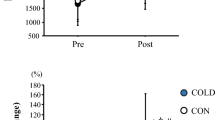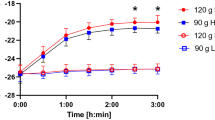Abstract
The aim of this study was to examine hydrogen (H2) production with the hydrogen breath test (HBT) after ingesting primarily digestible carbohydrate (CHO) during 3 h of 75% maximal oxygen consumption exercise. This was done to indicate CHO overflow in the colon which may occur when gastric emptying, intestinal transit and CHO absorption are not matched and CHO accumulates in the colon where it is subject to bacterial degradation. Further, this study was designed to assess breath H2 production as a function of the type of CHO ingested and the type of exercise. A group of 32 male triathletes performed three exercise trials at 1-week intervals with either a semi-solid (S) intake, an equal energy fluid intake (F) or a fluid placebo (P). Each trial consisted of cycling (sessions 1 and 3) and running (sessions 2 and 4). The mixed-expired H2 concentrations in the resting and “recovery” periods (5 min after each session) did not change significantly in. time and did not differ among intakes. There were also no significant differences in H2 concentrations between resting and “recovery” conditions. During exercise, H2 concentrations decreased three to six-fold in comparison to resting and recovery levels and differed among intakes (ANOVA;P < 0.05). The H2 on concentrations were almost continuously lower with P than with F and S. The H2 concentrations were significantly higher during running than during cycling. During exercise, we found that CHO overflow could be compared among intakes and between exercise types by using the HBT, provided the influence of other factors on H2 excretion — ventilation and intestinal blood flow — was similar for each condition.
Similar content being viewed by others
References
Barclay GR, Turnberg LA (1988) Effect of exercise on salt and water transport in the human jejunum. Gut 29:816–820
Bjørneklett A, Jensen E (1982) Relationship between hydrogen (H2) and methane (CH4) production in man. Scand J Gastroenterol 17:985–992
Cammack J, Read NW, Cann PA, Greenwood D, Holgate AM (1982) Effect of prolonged exercise on the passage of a solid meal through the stomach and small intestine. Gut 23:957–961
Douwes AC, Fernandes J, Rietveld W (1978) Hydrogen breath test in infants and children: sampling and storing expired air. Clin Chim Acta 82:293–296
Fordtran JS, Saltin B (1967) Gastric emptying and intestinal absorption during prolonged severe exercise. J Appl Physiol 23:331–335
Keeling WF, Martin BJ (1987) Gastrointestinal transit during mild exercise. J Appl Physiol 63:978–981
Klei-Moorsel JM van der, Douwes AC, Oeveren JP van (1984) New principle for estimation of hydrogen in expired air. Eur J Pediatr 141:221–224
Kneepkens F (1988) Carbohydrate absorption in children. New aspects of the breath hydrogen test. Thesis, University of Groningen, Groningen
Lefèbvre PJ, Pirnay F, Pallikarakis N, Krzentowski G, Jandrain B, Mosora F, Lacroix M, Luyckx AS (1986) Metabolic availability of carbohydrates ingested during, before, or after muscular exercise. Diabetes Metab Rev 1:483–500
Levitt MD (1969) Production and excretion of hydrogen gas in man. N Engl J Med 281:122–127
Levitt MD, Engel RR (1975) Intestinal gas. Adv Intern Med 20:151–165
Levitt MD, Hirsh P, Fetzer CA, Sheahan M, Levine AS (1987) H2 excretion after ingestion of complex carbohydrates. Gastroenterology 92:383–389
Meshkinpour H, Kemp C, Fairshter R (1989) Effect of aerobic exercise on mouth- to caecum transit time. Gastroenterology 96:983–991
Moses FM, Ryan C, DeBolt J, Smoak B, Hoffman A (1988) Oral cecal transit time during a 2 hr run with ingestion of water or glucose polymer. Am J Gastroenterol 83:1055
NEVO (1989/1990) Netherlands Food Composition Table (in dutch). Stichting NEVO Zeist, The Hague, Netherlands (The Netherlands Bureau for Food and Nutrition Information)
Norryd C, Dencker H, Lundenquist A, Olin T, Tylen U (1975) Superior mesenteric blood flow during digestion in man. Acta Chir Scand 141:197–202
Payne DL, Welsh JD, Claypool PL (1983) Breath hydrogen (H2) response to carbohydrate malabsorption after exercise. J Lab Clin Med 102:147–150
Perman JA (1991) Clinical application of breath hydrogen measurements. Can J Physiol Pharmacol 69:111–115
Perman JA, Waters LA, Harrison MR, Yee ES, Heldt GP (1981) Breath hydrogen reflects canine intestinal ischemia. Pediatr Res 15:1229–1233
Perman JA, Modler S, Engel RR, Heldt G (1985) Effect of ventilation on breath hydrogen measurements. J Lab Clin Med 105:436–439
Peters HPF, Schelven WF van, Verstappen PA, Boer RW de, Bol E, Erich WBM, Togt CR van der, Vries WR de (1993) Gastro-intestinal problems as a function of carbohydrate and mode of exercise. Med Sci Sports Exerc [Suppl] 25:1211–1224
Qamar MI, Read AE (1987) Effects of exercise on mesenteric blood flow in man. Gut 28:583–587
Rehrer NJ, Meijer GA (1991) Biomechanical vibration of the abdominal region during running and bicycling. J Sports Med 31:231–234
Solomons NW, Garcia R, Schneider R, Viteri FE, Kaenel VA von (1979) H2 breath tests during diarrhea. Acta Paediatr Scand 68:171–172
Varro GE, Harris JA, Geenen JE (1965) Effect of decreased local circulation on the absorptive capacity of a small intestine loop in the dog. Am J Digest Dis 10:170–177
Wade OL, Bishop JM (1962) Cardiac output and regional blood flow. Blackwell Scientific Publications, Oxford
Author information
Authors and Affiliations
Rights and permissions
About this article
Cite this article
Peters, H.P.F., Schep, G., Koster, D.J. et al. Hydrogen breath test as a simple noninvasive method for evaluation of carbohydrate malabsorption during exercise. Europ. J. Appl. Physiol. 68, 435–440 (1994). https://doi.org/10.1007/BF00843742
Accepted:
Issue Date:
DOI: https://doi.org/10.1007/BF00843742




